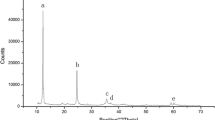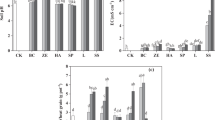Abstract
Soil contamination with cadmium (Cd) represents a substantial threat to human health and environmental quality. Long-term effectiveness and persistence of remediation are two important criteria for the evaluation of amendment techniques used to remediate soils polluted with potentially toxic metals. In the current study, we investigated the remediation persistence of a natural sepiolite bearing material (NSBM, containing 15% sepiolite) and ground limestone (equivalent to > 98.0% CaO) on soil pH, Cd bioavailability, and Cd accumulation by pak choi (Brassica chinensis L.) during the growth of four consecutive crops in a Cd-contaminated acid soil with different amounts of NSBM (0, 0.2, 0.5, 1, 2, and 5%). Soil pH levels ranged from 5.21 to 7.76 during the first crop, 4.30 to 7.34 during the second, 4.23 to 7.80 during the third, and 4.33 to 6.98 during the fourth, and increased significantly with increasing the application rate of NSBM. Soil CaCl2-Cd and shoot Cd concentrations decreased by 8.11 to 99.2% and 6.58 to 94.5%, respectively, compared with the control throughout the four cropping seasons. A significant negative correlation was found between soil CaCl2-Cd and soil pH. Combined use of 0.1% lime and NSBM showed greater effects than NSBM alone, especially, when the application rate of NSBM was ˂ 2%. Moreover, pak choi tissue Cd concentrations in the treatments with NSBM addition alone at ≥ 2% or at ≥ 1% NSBM combined with 0.1% lime met the maximum permissible concentration (MPC) over the four crops, allowed by the Chinese and European regulations. Based on the present study, safe crop production in the test soil is possible at a soil pH > 6.38 and CaCl2-Cd < 14 μg kg−1, and soil Cd immobilization by NSBM without or with lime is a potentially feasible method of controlling the transfer of soil Cd into the food chain.



Similar content being viewed by others
References
Abad-Valle P, Alvarez-Ayuso E, Murciego A, Pellitero E (2016) Assessment of the use of sepiolite amendment to restore trace metal polluted mine soil. Geoderma 280:57–66. https://doi.org/10.1016/j.geoderma.2016.06.015
Adrees M, Ali S, Rizwan M, Ibrahim M, Abbas F, Farid M, Zia-ur-Rehman M, Irshad MK (2015) The effect of excess copper on growth and physiology of important food crops: a review. Environ Sci Pollut Res 22(11):8148–8162. https://doi.org/10.1007/s11356-015-4496-5
Adriano DC, Wenzel WW, Vangroneveld J, Bolan NS (2004) Role of assisted natural remediation in environmental cleanup. Geoderma 122:121–142. https://doi.org/10.1016/j.geoderma.2004.01.003
Aksakal EL, Angin I, Oztas T (2013) Effects of diatomite on soil consistency limits and soil compactibility. Catena 101:157–163. https://doi.org/10.1016/j.catena2012.09.001
Bolan N, Kunhikrishnan A, Thangarajan R, Kumpieme J, Park J, Makino T, Kirkham MB, Scheckel K (2014) Remediation of heavy metal (loid)s contaminated soils—to mobilize or to immobilize? J Hazard Mater 266(4):141–166. https://doi.org/10.1016/j.jhazmat.2013.12.018
Che J, Zhao XQ, Zhou X, Jia ZJ, Shen RF (2015) High pH-enhanced soil nitrification was associated with ammonia-oxidizing bacteria rather than archaea in acidic soils. Appl Soil Ecol 85:21–29. https://doi.org/10.1016/j.apsoil.2014.09.003
Chen SB, Xu MG, Ma YB, Yang JC (2007) Evaluation of different phosphate amendments on availability of metals in contaminated soil. Ecotoxicol Environ Saf 67(2):278–285. https://doi.org/10.1016/j.ecoenv.2006.06.008
Chen CR, Phillips IR, Wei LL, Xu ZH (2010a) Behaviour and dynamics of di-ammonium phosphate in bauxite processing residue sand in Western Australia-II. Phosphorus fractions and availability. Environ Sci Pollut Res 17(5):1110–1118. https://doi.org/10.1007/s11356-009-0268-4
Chen GQ, Chen Y, Zeng GM, Zhang JC, Chen YN, Wang LA, Zhang WJ (2010b) Speciation of cadmium and changes in bacterial communities in red soil following application of cadmium-polluted compost. Environ Eng Sci 27(12):1019–1026. https://doi.org/10.1089/ees.2010.0015
Choppala G, Saifullah BN, Bibi S, Lqbal M, Rengel Z, Kunhikrishnan A, Ashwath N, Ok YS (2014) Cellular mechanisms in higher plants governing tolerance to cadmium toxicity. Crit Rev Plant Sci 33(5):374–391. https://doi.org/10.1080/07352689.2014.903747
Cui HB, Zhou J, Si YB, Mao JD, Zhao QG, Fang GD, Liang JN (2014) Immobilization of Cu and Cd in a contaminated soil: one- and four-year field effects. J Soils Sediments 14(8):1397–1406. https://doi.org/10.1007/s11368-014-0882-8
Du YL, He MM, Xu M, Yan ZG, Zhou YY, Guo GL, Nie J, Wang LQ, Hou H, Li FS (2014) Interactive effects between earthworms and maize plants on the accumulation and toxicity of soil cadmium. Soil Biol Biochem 72:193–202. https://doi.org/10.1016/j.soilbio.2014.02.004
Eghball B, Sander DH, Skopp J (1990) Diffusion, adsorption, and predicted longevity of banded phosphorus-fertilizer in three soils. Soil Sci Soc Am J 54(4):1161–1165. https://doi.org/10.2136/sssaj1990.03615995005400040041x
Ernani PR, Mantovani A, Scheidt FR, Nesi C (2012) Liming decreases the vertical mobility of potassium in acidic soils. Commun Soil Sci Plant Anal 43(19):2544–2549. https://doi.org/10.1080/00103624.2012.711876
Farooq MA, Ali S, Hameed A, Bharwana SA, Rizwan M, Ishaque W, Farid M, Mahmood K, Lqbal Z (2016) Cadmium stress in cotton seedlings: physiological, photosynthesis and oxidative damages alleviated by glycinebetaine. S Afr J Bot 104:61–68. https://doi.org/10.1016/j.sajb.2015.11.006
Feng RW, Qiu WW, Lian F, Yu ZH, Yang YX, Song ZG (2013) Field evaluation of in situ remediation of Cd-contaminated soil using four additives, two foliar fertilisers and two varieties of pakchoi. J Environ Manag 124:17–24. https://doi.org/10.1016/j.jenvman.2013.03.037
Gai XP, Wang HY, Liu J, Zhai LM, Liu S, Ren TZ, Liu HB (2014) Effects of feedstock and pyrolysis temperature on biochar adsorption of ammonium and nitrate. PLoS One 9(12):e113888. https://doi.org/10.1371/journal.pone.0113888
Gong ZT, Zhang GL, Chen ZC (2007) Pedogenesis and soil taxonomy. China Science Press, Beijing (in Chinese)
He ZL, Alva AK, Calvert DV, Banks DJ (1999) Ammonia volatilization from different fertilizer sources and effects of temperature and soil pH 1. Soil Sci 164(10):750–758. https://doi.org/10.1097/00010694-199910000-00006
Houben D, Pircar J, Sonnet P (2012) Heavy metal immobilization by cost-effective amendments in a contaminated soil: effects on metal leaching and phytoavailability. J Geochem Explor 123:87–94. https://doi.org/10.1016/j.gexplo.2011.10.004
Hu PJ, Huang JX, Ouyang YN, Wu LH, Song J, Wang SF, Li Z, Han CL, Zhou LQ, Huang YJ, Luo YM, Christie P (2013) Water management affects arsenic and cadmium accumulation in different rice cultivars. Environ Geochem Health 35(6):767–778. https://doi.org/10.1007/s10653-013-9533-z
Islam A, White RE, Chen D (2006) Nitrification activity in acid soils of North-Eastern Victoria, Australia, as affected by liming and phosphorus fertilisation. Aust J Soil Res 44(8):739–744. https://doi.org/10.1071/SR06058
Kahr G, Madsen FT (1995) Determination of the cation exchange capacity and the surface area of bentonite, illite and kaolinite by methylene blue adsorption. Appl Clay Sci 9(5):327–336. https://doi.org/10.1016/0169-1317(94)00028-O
Khan MU, Shahbaz N, Waheed S, Mahmood A, Shinwari ZK, Malik RN (2016) Comparative health risk surveillance of trace metals via dietary foodstuff consumption in different land-use types of Pakistan. Human and Ecological Risk Assessment: An International Journal 22:168–186. https://doi.org/10.1080/10807039.2015.1056294
Lee SH, Kim EY, Park H, Yun J, Kim JG (2011) In situ stabilization of arsenic and metal-contaminated agricultural soil using industrial by-products. Geoderma 161(1–2):1–7. https://doi.org/10.1016/j.geoderma.2010.11.008
Li CF, Liu YG, Zeng GM, Xu WH, Tang CF, Li X (2005) A effect of pH on cadmium adsorption behavior in red soils. Journal of Agro-Environment Science 1:84–88 (in Chinese)
Li SM, Banuelos GS, Wu LH, Shi WM (2014a) The changing selenium nutritional status of Chinese residents. Nutrients 6(3):1103–1114. https://doi.org/10.3390/nu6031103
Li Z, Wu LH, Hu PJ, Luo YM, Zhang H, Christie P (2014b) Repeated phytoextraction of four metal-contaminated soils using the cadmium/zinc hyperaccumulator Sedum plumbizincicola. Environ Pollut 189:176–183. https://doi.org/10.1016/j.envpol.2014.02.034
Liang XF, Han J, Xu YM, Sun YB, Wang L, Tan X (2014) In situ field-scale remediation of Cd polluted paddy soil using sepiolite and palygorskite. Geoderma 235–236:9–18. https://doi.org/10.1016/j.geoderma.2014.06.029
Liang XF, Xu Y, Xu YM, Wang PC, Wang L, Sun YB, Huang QQ, Huang R (2016) Two -year stability of immobilization effect of sepiolite on Cd contaminants in paddy soil. Environ Sci Pollut Res 23(13):12922–12931. https://doi.org/10.1007/s11356-016-6466-y
Lima AT, Ottosen LM, Ribeiro AB (2012) Assessing fly ash treatment: remediation and stabilization of heavy metals. J Environ Manag 95:s110–s115. https://doi.org/10.1016/j.jenvman.2010.11.009
Pathan SM, Aylmore LAG, Colmer TD (2002) Reduced leaching of nitrate, ammonium, and phosphorus in a sandy soil by fly ash amendment. Aust J Soil Res 40(7):1201–1211. https://doi.org/10.1071/SR02019
Peter A, Mihaly-Cozmuta L, Mihaly-Cozmuta A, Nicula C, Indrea E, Tutu H (2012) Calcium- and ammonium ion-modification of zeolite amendments affects the metal-uptake of Hieracium piloselloides in a dose-dependent way. J Environ Monit 14(10):2807–2814. https://doi.org/10.1039/c2em30301a
Qian YZ, Chen C, Zhang Q, Li Y, Chen ZJ, Li M (2010) Concentrations of cadmium, lead, mercury and arsenic in Chinese market milled rice and associated population health risk. Food Control 21(12):1757–1763. https://doi.org/10.1016/j.foodcont.2010.08.005
Rizwan M, Ali S, Adress M, Rizvi H, Zia-ur-Rehman M, Hannan F, Qayyum MF, Hafeez F, Ok YS (2016) Cadmium stress in rice: toxic effects, tolerance mechanisms and management: a critical review. Environ Sci Pollut Res 23(18):17859–17879. https://doi.org/10.1007/s11356-016-6436-4
Siebielec G, Chaney RL (2012) Testing amendments for remediation of military range contaminated soil. J Environ Manag 108:8–13. https://doi.org/10.1016/j.jenvman.2012.04.028
Simmler M, Ciadamidaro L, Schulin R, Madejon P, Reiser R, Clucas L, Weber P, Robinson B (2013) Lignite reduces the solubility and plant uptake of cadmium in pasturelands. Environmental Science & Technology 47(9):4497–4504. https://doi.org/10.1021/es303118a
Sparks DL, Page AL, Helmke PA, Loeppert RH, Soltanpour PN, Tabatabai MA, Johnston CT, Sumner ME (1996) Methods of soil analysis. Part 3-chemical methods. Soil Science Society of America Inc., Madison, pp 475–491
Suárez M, García-Romero E (2011) Advances in the crystal chemistry of sepiolite and palygorskite. In: Galan E, Singer A (eds) Developments in Palygorskite-sepiolite Research: a new outlook on these nanomaterials, 3rd edn. Developments in Clay Science, Amsterdam, pp 33–65
Sun YB, Sun GH, Xu YM, Wang L, Lin DS, Liang XF, Shi X (2012) In situ stabilization remediation of cadmium contaminated soils of wastewater irrigation region using sepiolite. J Environ Sci 24(10):1799–1805. https://doi.org/10.1016/S1001-0742(11)61010-3
Sun YB, Sun GH, Xu YM, Wang L, Liang XF, Lin DS (2013) Assessment of sepiolite for immobilization of cadmium-contaminated soils. Geoderma 193:149–155. https://doi.org/10.1016/j.geoderma.2012.07.012
Tica D, Udovic M, Lestan D (2011) Immobilization of potentially toxic metals using different soil amendments. Chemosphere 85(4):577–583. https://doi.org/10.1016/j.chemosphere.2011.06.085
Udovic M, Drobne D, Lestan D (2013) An in vivo invertebrate bioassay of Pb, Zn and Cd stabilization in contaminated soil. Chemosphere 92(9):1105–1110. https://doi.org/10.1016/j.chemosphere.2013.01.054
Wang LT, Tong ZH, Liu GD, Li YC (2014) Characterization of biomass residues and their amendment effects on water sorption and nutrient leaching in sandy soil. Chemosphere 107:354–359. https://doi.org/10.1016/j.chemosphere.2013.12.088
Wu YJ, Zhou H, Zou ZJ, Zhu W, Yang WT, Peng PQ, Zeng M, Liao BH (2016) A three-year in-situ study on the persistence of a combined amendment (limestone + sepiolite) for remedying paddy soil polluted with heavy metals. Ecotoxicol Environ Saf 130:163–170. https://doi.org/10.1016/j.ecoenv.2016.04.018
Xu Y, Liang XF, Xu YM, Qin X, Huang QQ, Wang L, Sun YB (2017) Remediation of heavy metal-polluted agricultural soils using clay minerals: a review. Pedosphere 27(2):193–204. https://doi.org/10.1016/S1002-0160(17)60310-2
Ye XX, Ma YB, Sun B (2012) Influence of soil type and genotype on Cd bioavailability and uptake by rice and implications for food safety. J Environ Sci 24(9):1647–1654. https://doi.org/10.1016/S1001-0742(11)60982-0
Zhu YG, Chen SB, Yang JC (2004) Effects of soil amendments on lead uptake by two vegetable crops from a lead-contaminated soil from Anhui, China. Environ Int 30(3):351–356. https://doi.org/10.1016/j.envint.2003.07.001
Funding
This research was financially supported by the National Natural Science Foundation of China (Grant 41325003) and the Key Research and Technology Project of Hunan Province (Grant 2017NK2141).
Author information
Authors and Affiliations
Corresponding author
Additional information
Responsible editor: Roberto Terzano
Rights and permissions
About this article
Cite this article
Cao, X., Hu, P., Tan, C. et al. Effects of a natural sepiolite bearing material and lime on the immobilization and persistence of cadmium in a contaminated acid agricultural soil. Environ Sci Pollut Res 25, 22075–22084 (2018). https://doi.org/10.1007/s11356-018-1988-0
Received:
Accepted:
Published:
Issue Date:
DOI: https://doi.org/10.1007/s11356-018-1988-0




